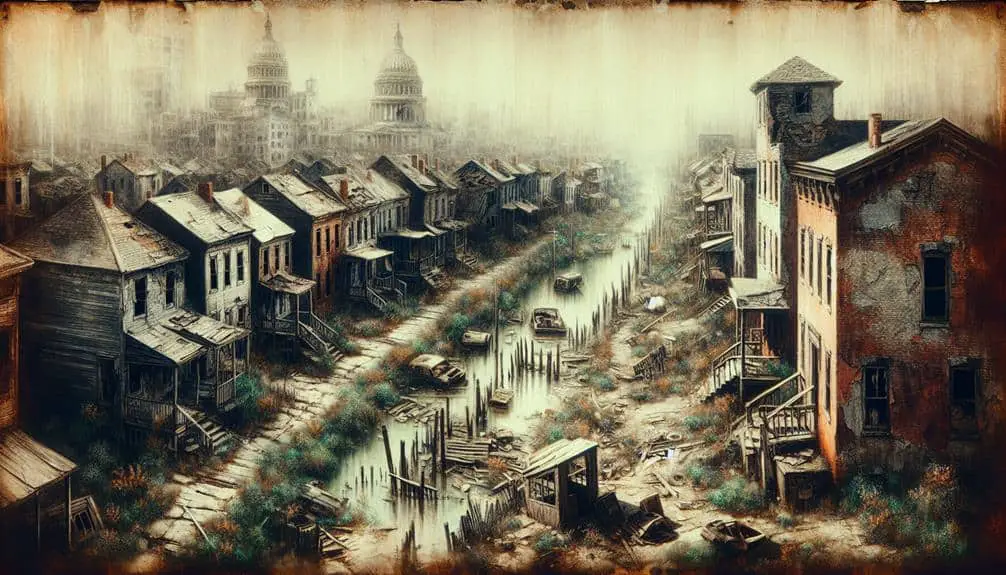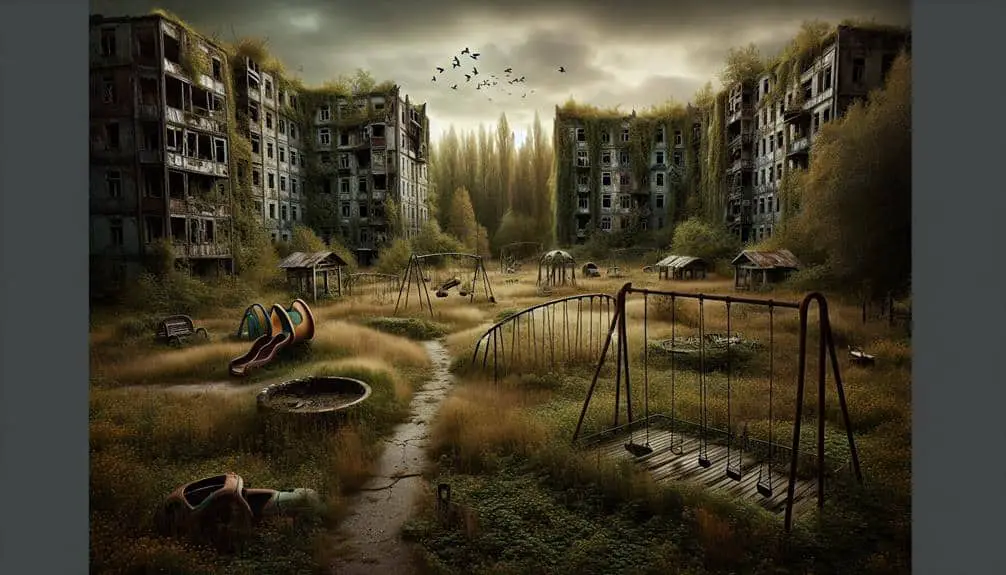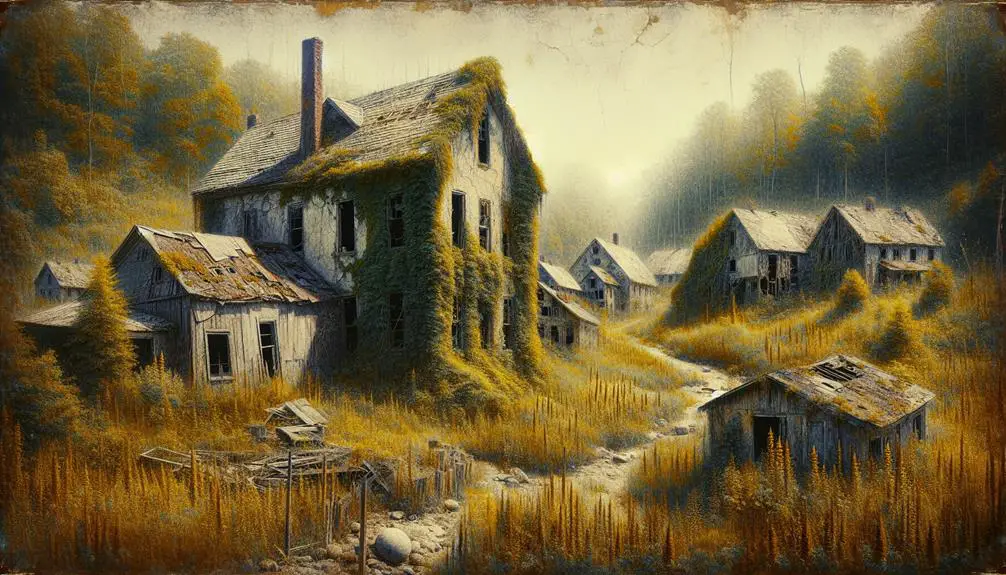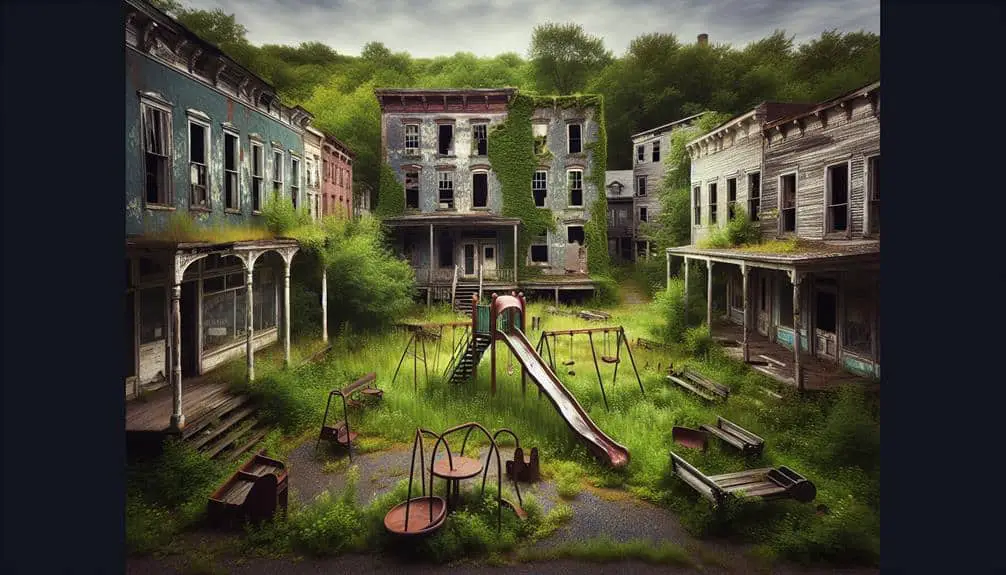Examine the remnants of New Harmony, a utopian society founded in 1825, promoting communal living and equality. Witness the tension in the Amana Colonies, where conflicts over leadership led to its downfall amidst economic struggles. Discover the rise and fall of Rajneeshpuram, an abandoned vision of spiritual utopia plagued by power struggles. Unearth the mysterious ruins of Cahokia, illuminating hidden cultural richness and ancient civilizations. To conclude, encounter Centralia's legacy, a cautionary tale of environmental disaster displacing a thriving community. Each story reveals secrets of abandoned utopias left to decay, hinting at deeper narratives waiting to be uncovered.
Key Points
- New Harmony and Amana Colonies struggled with leadership conflicts and economic hardships.
- Rajneeshpuram faced internal power struggles and legal battles, leading to its downfall.
- The Mysterious Ruins of Cahokia challenge understanding of pre-Columbian societies.
- Centralia's legacy serves as a cautionary tale of environmental neglect and community displacement.
- Deserted dreams of utopian societies highlight the complexities of communal living and sustainability.
Rise and Fall of New Harmony
In exploring the rise and fall of New Harmony, one can't ignore the pivotal role played by idealism in shaping the community's trajectory. Founded in 1825 by Robert Owen, a Welsh industrialist and social reformer, New Harmony was envisioned as a utopian society where communal living and equality thrived. The residents of New Harmony aimed to create a haven free from the social inequalities and injustices prevalent in the outside world.
The concept of communal living was central to the community's ideals. Resources were shared, and labor was divided equally among all members. This utopian vision attracted intellectuals, scientists, and artists, all drawn to the promise of a harmonious existence based on cooperation and shared values.
However, despite the noble intentions behind New Harmony, the experiment ultimately faltered. Internal conflicts, differing ideologies, and the challenges of sustaining a communal lifestyle led to the community's decline. The case of New Harmony serves as a poignant reminder of the complexities involved in realizing utopian ideals within a communal setting.
Failed Experiment: Amana Colonies
The Amana Colonies' utopian vision crumbled under the weight of internal discord and external pressures, leading to their eventual demise. Founded by German Pietists seeking religious freedom and communal living, the Amana Colonies were meant to embody harmony and cooperation. However, as time passed, challenges arose.
Within the colonies, disagreements over leadership and the distribution of resources caused rifts among residents. The communal structure that was meant to foster unity began to strain under the pressures of differing opinions and individual ambitions. Externally, economic hardships and the desire for modernization clashed with the traditional way of life upheld by the Amana Colonies.
Despite their shared German heritage and initial aspirations for a collective existence, the Amana Colonies couldn't withstand the complexities of human nature and the changing world around them. The once-promising experiment in communal living ultimately faltered, serving as a cautionary tale about the delicate balance between utopian ideals and practical realities.
Deserted Dreams of Rajneeshpuram
Amidst the remote landscapes of Oregon, lies a once-thriving community known as Rajneeshpuram, now abandoned and shrouded in the echoes of unfulfilled aspirations. Founded in the 1980s by the controversial cult leader Bhagwan Shree Rajneesh, this commune was envisioned as a utopian society guided by spiritual principles. However, internal power struggles, legal battles, and clashes with the local community led to its eventual downfall.
Rajneeshpuram, with its striking architecture and vast lands, attracted followers seeking an alternative way of life. The allure of communal living and the teachings of Bhagwan drew people from far and wide. Yet, behind the facade of peace and enlightenment, darker truths emerged. The cult leader's authoritarian control and the commune's questionable practices stirred up a storm of controversy.
Today, Rajneeshpuram stands as a ghostly reminder of grand ambitions gone awry. The abandoned buildings and overgrown fields whisper tales of broken dreams and shattered ideals. The legacy of this once-controversial commune serves as a cautionary tale about the dangers of blind devotion and unchecked power.
The Mysterious Ruins of Cahokia
Echoes of forgotten civilizations linger among the mysterious ruins of Cahokia, a once-thriving pre-Columbian settlement nestled in the heart of America. As you wander through this ancient site, you can't help but feel a sense of wonder and curiosity about the people who once called this place home. Here are three intriguing aspects that add to the mystique of Cahokia:
- Mysterious Artifacts: Archaeologists have unearthed a plethora of enigmatic artifacts at Cahokia, ranging from intricate pottery to symbolic figurines. These objects provide valuable insights into the daily lives and belief systems of the ancient Cahokians.
- Archaeological Discoveries: Recent excavations have revealed fascinating details about the layout and organization of Cahokia, including its sophisticated urban planning, massive earthen mounds, and expansive trade networks. These discoveries challenge our understanding of pre-Columbian societies in North America.
- Cultural Validation: The ruins of Cahokia stand as a validation to the ingenuity and cultural richness of indigenous peoples who flourished in this region long before European contact. Exploring these ancient remnants offers a glimpse into a world shrouded in mystery and beckons you to unravel its secrets.
Faded Hopes: Centralias Legacy
Exploring Centralia's legacy reveals a haunting narrative of faded hopes and abandoned dreams. Once a thriving mining town in Pennsylvania, Centralia's fate took a grim turn due to an environmental disaster that ignited a series of underground coal mine fires in the early 1960s. The relentless flames spewing toxic gases led to the gradual displacement of the community as the government deemed the town unsafe for habitation.
The legacy of Centralia serves as a stark reminder of the devastating consequences of unchecked industrial practices and the long-term impacts of environmental neglect. The once bustling streets now lie eerily quiet, obscured by the ominous smoke that continues to rise from the ground, a poignant symbol of a community lost to the ravages of man-made disaster.
As you contemplate Centralia's legacy, you're confronted with the sobering reality of how quickly hopes can fade and dreams can crumble in the face of environmental degradation and community displacement. It stands as a cautionary tale, urging us to tread carefully in our pursuit of progress and development, mindful of the delicate balance between human ambition and environmental stewardship.
Frequently Asked Questions
What Were the Specific Reasons for the Decline and Abandonment of New Harmony?
You witnessed New Harmony's unraveling firsthand. Economic struggles, clashing ideals, and fading dreams led to its demise. Social experiments collided with reality, revealing the fragility of utopian aspirations and the weight of unmet expectations.
How Did the Amana Colonies Initially Attract Settlers and What Led to Their Ultimate Failure as a Communal Society?
You were drawn to the Amana Colonies by promises of communal living and shared prosperity. However, the ultimate failure stemmed from a lack of adaptability, rigid social structure, and economic challenges that led to the demise of this once-thriving society.
What Were the Key Factors That Contributed to the Downfall of Rajneeshpuram and the Eventual Desertion of the Community?
You saw Rajneeshpuram crumble due to leadership dynamics and social conflicts. Economic sustainability and land mismanagement added to the downfall. Freedom sought turned into a mirage as the community dissolved, deserted by disillusioned residents.
What Theories Exist About the Mysterious Ruins of Cahokia and Why Did This Once-Thriving City Eventually Become Deserted?
Archaeological discoveries shed light on Cahokia's mysterious ruins. Environmental factors like climate change and societal shifts may have led to its desertion. The city's cultural significance remains, echoing a past civilization's rise and fall.
How Did Centralia's Legacy Impact the Surrounding Communities and What Efforts Have Been Made to Preserve Its History Despite Its Faded Hopes for the Future?
You've wondered about Centralia's legacy and historical preservation efforts. Its impact on neighboring communities remains palpable. Despite faded hopes, revitalization efforts persist. The town's story, though tinged with tragedy, continues to inspire.



